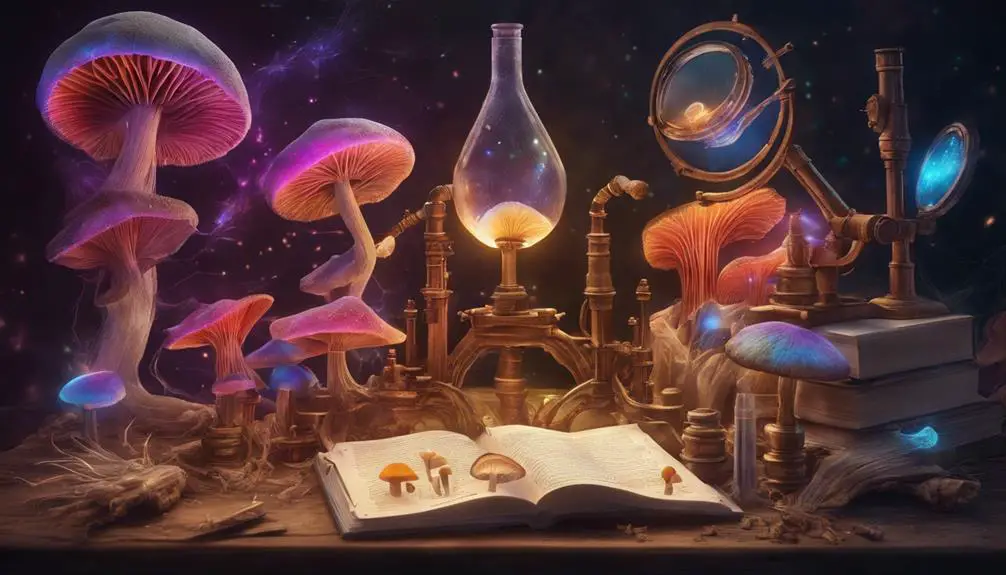From Moses' burning bush to ancient rituals, explore the controversial ties between magic mushrooms and biblical stories, sparking divine debate.

Magic Mushrooms in the Bible
You might've missed the chapter in Sunday school that covered Moses tripping on magic mushrooms, leading to a rather vivid encounter with a burning bush. While this imagery springs from satire, it opens up a fascinating dialogue about the historical context and interpretations of psychedelic substances, like magic mushrooms, within ancient texts, including the Bible.
Scholars have long debated the presence and significance of these substances in early religious rituals and scriptural symbolism. By exploring the interplay between scholarly theories and modern research, you stand at the threshold of unraveling how our ancestors possibly experienced the divine.
Key Takeaways
- Ancient religious texts may contain symbolic references to psychedelic mushrooms.
- Ritualistic consumption of mushrooms in indigenous cultures hints at their spiritual significance.
- Shamanic practices often involve mushrooms, suggesting a historical connection to spiritual experiences.
- The psychoactive properties of mushrooms could have influenced their symbolic presence in religious narratives.
Historical Context and Interpretations

The historical context and interpretations of references to magic mushrooms in the Bible demand a multidisciplinary approach, blending theology, history, and ethnobotany to uncover potential insights. You're navigating a complex terrain where cultural influences and archaeological evidence intersect, shedding light on ancient practices and beliefs.
Cultural influences play a pivotal role in understanding how ancient societies might've perceived and utilized psychoactive substances, including magic mushrooms. These influences can guide your interpretation of biblical texts, suggesting that what's described could be more than mere metaphor. You delve into the symbology embedded within scripture, considering how the cultural backdrop of the time shapes our understanding of these passages today.
Moreover, archaeological evidence offers tangible clues. You explore findings from ancient sites, where artifacts and botanical remains hint at the use of psychoactive substances in religious and spiritual contexts. This evidence, while not definitive, encourages a reevaluation of traditional interpretations of biblical texts.
In this analytical journey, you're piecing together a multidisciplinary puzzle. By examining cultural influences and archaeological evidence, you're opening the door to a nuanced discussion about the presence and significance of magic mushrooms in biblical times, steering clear of oversimplification and embracing the complexity of historical interpretation.
Psychedelics in Ancient Rituals

Exploring the role of psychedelics in ancient rituals, we find that these substances often served as gateways to divine encounters, spiritual awakenings, and communal bonding, deeply embedded within the cultural and religious fabric of societies. You'll discover that shamanic practices across various cultures harnessed the transformative power of psychedelics, not just for healing physical ailments but also for navigating the spiritual realm. This multidisciplinary approach reveals the intricate ways these substances intertwined with human consciousness and societal norms.
Culture |
Substance Used |
Ritual Significance |
|---|---|---|
South American |
Ayahuasca |
Vision quests and healing ceremonies |
Siberian Shamanism |
Amanita muscaria |
Communication with the spirit world |
Ancient Greece |
Kykeon |
Eleusinian Mysteries, a rite of passage |
These practices underscore the ritual significance of psychedelics, highlighting their role in facilitating profound experiences that were believed to connect individuals with higher realms of existence. This exploration not only enriches our understanding of ancient rituals but also sheds light on the enduring human quest for spiritual enlightenment and the communal bonds forged through shared mystical experiences.
Scriptural Symbolism and Mushrooms

Building on our understanding of psychedelics in ancient rituals, let's now examine how mushrooms, particularly those with hallucinogenic properties, are symbolically represented in biblical scriptures. The exploration into scriptural symbolism reveals a fascinating intersection between religious texts and the natural world, specifically through the lens of fungal metaphors and plant allegories.
In the biblical context, the symbolic representation of mushrooms—and more broadly, plants—often transcends literal interpretations, weaving a rich tapestry of spiritual and moral lessons. For instance, consider the parables, a foundational method Jesus used to impart wisdom. These stories frequently employ plant allegories, suggesting a deeper, possibly esoteric, layer to their interpretation. While the explicit mention of mushrooms is scarce, the use of fungal metaphors could be subtly embedded within these texts, symbolizing themes of growth, decay, and resurrection—central tenets to Christian doctrine.
Analyzing these allegories requires a multidisciplinary approach, combining theology, botany, and anthropology. This amalgamation of disciplines allows for a nuanced understanding of how ancient peoples might've perceived and incorporated the natural world into their spiritual practices. It's a reminder of the complexity and depth of biblical symbolism, inviting readers to ponder the potential intersections between the spiritual and the natural.
Scholarly Theories and Debates

Scholars have long debated the presence and significance of psychedelic mushrooms in biblical texts, employing a multidisciplinary lens to dissect these contentious interpretations. Through linguistic analysis, some researchers argue that certain Hebrew and Aramaic terms could reference psychoactive substances, including mushrooms. This approach requires a deep dive into ancient languages and the cultural context surrounding the texts, challenging traditional interpretations with etymological evidence.
Similarly, archaeological evidence contributes to this debate. Excavations in regions mentioned in the Bible have uncovered artifacts and frescoes that some argue depict the use of mushrooms in religious rites. These findings prompt a reevaluation of our understanding of ancient religious practices, suggesting that psychoactive plants might've played a role in achieving spiritual experiences or communing with the divine.
However, these theories aren't without their critics. Skeptics question the reliability of linguistic and archaeological interpretations, pointing out the potential for anachronism or misreading of the evidence. They argue that without more direct references to mushrooms or their effects, such interpretations remain speculative.
This scholarly debate underscores the complexity of interpreting ancient texts and artifacts, highlighting the need for a careful, multidisciplinary approach. As you delve deeper into this topic, consider how each piece of evidence contributes to or challenges the prevailing understanding of psychedelic substances in biblical history.
Modern Perspectives and Research

While the debate among scholars about ancient texts and artifacts continues, recent research sheds new light on the role of psychedelic mushrooms in religious and spiritual practices today. You're now navigating a realm where neuroscience findings intersect with historical interpretations, challenging and expanding our understanding of sacred experiences.
The modern perspectives on these ancient practices are as diverse as they're groundbreaking, supported by a growing body of evidence that underscores the therapeutic applications and profound impacts of psilocybin, the active compound in psychedelic mushrooms. Here's a snapshot:
- Neuroscience Findings: Studies reveal that psilocybin significantly alters brain function, potentially enhancing spiritual experiences and fostering a deeper sense of connection.
- Therapeutic Applications: Research indicates promising results in treating depression, anxiety, and PTSD, suggesting a potential revival of these substances in spiritual healing practices.
- Multidisciplinary Approaches: Collaboration between historians, theologians, and scientists is crucial in understanding the multifaceted role of these substances across cultures and epochs.
- Ethical and Legal Considerations: The resurgence of interest prompts discussions on the ethical use and legal status of psychedelic substances in religious practices.
As you delve deeper into this topic, it's clear that the exploration of magic mushrooms in historical and religious contexts isn't just about the past but also about their relevance in today's search for meaning and well-being.
Frequently Asked Questions
How Do Current Religious Leaders From Various Faiths View the Use of Magic Mushrooms and Other Psychedelics in Spiritual Practice Today?
Today, you'll find that religious leaders across faiths have diverse views on using psychedelics like magic mushrooms for spiritual purposes. Ethical considerations often guide their opinions, leading to nuanced stances in interfaith dialogues.
While some see potential for deepened spiritual connection, others caution against their use, highlighting the importance of traditional practices. This multidisciplinary analysis reveals a complex landscape where faith, science, and personal belief intersect, challenging and enriching spiritual exploration.
What Are the Legal Implications and Restrictions Surrounding the Use of Psychedelics Like Magic Mushrooms in Religious Ceremonies Across Different Countries?
You're navigating complex terrain when considering the legal implications of using psychedelics in religious ceremonies. Countries vary widely in their approach, with some moving towards drug decriminalization, while others maintain strict prohibitions.
This legal patchwork complicates practice, potentially leading to accusations of cultural appropriation or disrespecting indigenous traditions. It's crucial to understand these multidisciplinary perspectives, as they shape the global dialogue on religious freedom and drug policy reform.
Are There Any Documented Cases of Adverse Psychological or Physical Effects From Using Magic Mushrooms in a Religious or Spiritual Context?
Yes, there are documented cases where using magic mushrooms in spiritual contexts led to adverse effects. Mushroom cultivation and historical usage in religious ceremonies have been studied extensively.
You'll find that while many report profound, positive changes, others experience negative psychological or physical reactions. These outcomes can vary widely, influenced by individual health, mindset, and the setting of use. It highlights the need for careful consideration and guidance when using psychedelics spiritually.
How Do Indigenous Practices Involving Magic Mushrooms Compare to the Interpretations and Practices Discussed in the Bible and Other Ancient Texts?
You'll find that indigenous practices involving magic mushrooms differ significantly from ancient texts.
While historical accuracy is challenging to pinpoint, it's crucial to understand this isn't just about differences; it's about recognizing and respecting cultural appropriation.
Indigenous rituals have deep-rooted meanings and purposes, often misunderstood or overlooked in scholarly interpretations.
As you delve into multidisciplinary analysis, remember to appreciate these practices' complexity and the cultural contexts they originate from.
Can the Use of Magic Mushrooms Enhance Personal Religious Experiences or Connections With the Divine, According to Personal Accounts or Studies Not Covered in Mainstream Research?
You're exploring whether magic mushrooms can deepen your spiritual experiences or divine connections. Personal stories and non-mainstream studies suggest they might, emphasizing their neurological effects and overcoming cultural stigma.
This inquiry crosses disciplines, merging psychology, spirituality, and anthropology. While scientific research is limited, anecdotal evidence indicates that these substances can facilitate profound religious experiences, challenging traditional views and urging a reevaluation of their role in spirituality.
Conclusion
In conclusion, you've navigated the complex interplay between historical context, ancient rituals, scriptural symbolism, and the scholarly debate surrounding the presence of magic mushrooms in the Bible. This multidisciplinary exploration reveals the nuanced perspectives and burgeoning research that challenge traditional interpretations.
As modern scholarship continues to evolve, it invites you to reconsider the spiritual and cultural dimensions of psychedelics, weaving a rich tapestry of historical, theological, and scientific inquiry that enriches our understanding of ancient texts.



Sign up